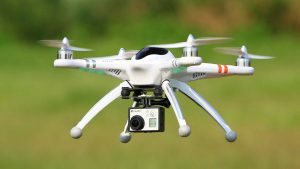Practicing with drone notes

Once, I brought to my bass teacher at University of Louisville, Chris Fitzgerald, a sketch of my ideas about setting a good practicing schedule. I am trying to find some basic principles about effective practice and my goal is to set a model of procedures that I can apply to any bass practicing situation, at any level. This specific subject will be covered in another text. While showing my findings to Chris, he took notes and pointed out some good stuff to consider. One of them was about practicing with drone notes.
The term drone became very popular lately because of the little airships that can carry video cameras and get nice aerial images. But the word drone means a steady and continuous sound. For practicing purposes, bass players with no frets on their instruments fingerboard (fretless and double bass) can use drone notes to work on intonation.
Before including practicing with drone notes on my research, I tried it for a little. At the very beginning, I noticed a huge difference. My intonation (I play the fretless bass) got way better and I could easily play without looking at the fingerboard (that is a thing that I must work on). I got more sensible to micro intonation variations and I got more confident on the results of my playing. That was amazing!
I know you can argue that playing or rehearsing with a live band or practicing with any other backing track would give me the same results, but, in these cases, there are several variables that can turn the practicing (or the performance) harder. Room’s acoustic, instruments balance, ambience noise, other instruments volume and intonation, etc. A drone note gives a steady and comfortable “pad” to work on intonation without any distraction.
Besides that, another thing that I figured out is that I could relate the sound of scales I was practicing to chords or keys. I know it is a little obvious, but, according to my practice schedule, I have a specific time to work on scales (technique practice) and another one to apply the scales of a chord progression (musical practice). The drone notes practicing made me relate scales and chords during my technique practice slot. Check the example below.
I was practicing the F melodic minor fingering on all fingerboard extension, aiming to apply it to the E7 altered chord. The obvious choice for the drone note would be the note F – the tonic of the scale. However, as my intention was the altered scale, I set E as the drone note. Thus, besides working on the fingering, I could relate the sound of the notes I was playing to the E7 altered chord.
You can apply the same idea to any other chord or scale. For example, if I worked on a Lydian dominant chord (4th mode of a melodic minor scale), when practicing F melodic minor, I would set Bb as the drone note. That is a very good way to work on intonation and having this new approach, fretted bass players can also benefit of the drone notes practicing.
If you want to practice with drone notes, I prepared a YouTube playlist with a chromatic scale drone notes. Just find the note you want work on and hit the play button.
See you on next text!!!!